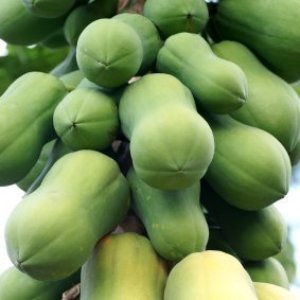
Native to southern Mexico and Central America, papayas (Carica papaya) are slender tropical trees growing as tall as 12-15 feet, with a spread of 3-6 feet at the crown. Their melon-like fruits have a yellow-orange flesh containing spicy, edible seeds, and a thin outer skin that varies in color from green to orange to rose.
Mature fruits measure up to 8 inches long and weigh anywhere from 1 to 20 pounds. Papaya plants are typically grown in the tropical and sub-tropical climates. In the United States, they are cold hardy to USDA Hardiness Zone 9, but they can also be grown as container plants indoors.The papaya plant can grow from seed to a 20 foot tall, fruit-bearing tree in only a couple of growing seasons. They are short-lived plants (most only reach 15 feet or so before dying), but they grow very quickly. When planting, choose a warm, sunny site with protection from strong winds, and space each tree 8 to 10 feet apart. Papayas require fertile, well-drained soil with a pH of 6.0-7.0. Although they will tolerate poor soils and mildly alkaline conditions, fruit quality and growth usually suffer. Good drainage is also essential, since the trees' shallow roots are sensitive to waterlogging and salty soils.
Most nursery-grown papaya plants come in 1 to 3-gallon containers. To plant one, dig the hole 3 to 4 times the diameter and 3 times as deep as the container the plant came in. Remove the plant from the container and place it in the hole so that the container is level with or slightly above the surrounding soil. Fill soil in around the tree roots and tamp slightly to remove air pockets and water in well. If you have the room, papaya trees also make good container plants.
Planting seeds: Sow 2 to 4 seeds in a 1-gallon pot filled with moist, sterilized soil and place the pot in a warm, sunny location (80ºF) until they germinate'usually in 2 to 5 weeks. Once the seedlings reach 12 to 18 inches tall, harden them off and transplant them to their final location.
Water: Consistent, evenly moist soil is the key to optimal growth and fruit production. Stress brought on by drought may result in flower and leaf drop, fruit drop, or small, bad tasting fruit.Too much water encourages root rot. In general, cooler weather requires less water. In winter, the plant prefers to remain on the dry side. In the summer keep the soil evenly moist.
Fertilizer: Papayas respond well to frequent applications of small amounts of fertilizer. Rates vary according to soil fertility and the tree's age. Start with a soil test, and then apply monthly feedings of an organic granular fertilizer formulated for fruit trees and make adjustments according the plant's response. Adding a layer of organic compost once or twice a year as mulch will also increase the soil's fertility.
Papaya trees do not need pruning because their main growing point is terminal. Should the main leader become damaged or killed, select 1 or 2 of the most vigorous side shoots and remove the others to facilitate growth and fruiting of the remaining shoots. After fruiting, prune the plant to 12 inches from the ground. When new shoots appear, select the strongest as the new leader and cut back the others.
Papaya pollination is a bit of a mystery. Horticulturists believe it is usually carried out by insects or the wind, although they are not exactly sure how it works. In some cases, hand pollination may be needed to ensure proper fruit set.
The gender of a papaya plant can be determined by its flower'male, female, or bisexual. To make sure you obtain at least a few fruit-bearing plants (females), plant several clumps of seedlings, and then thin them down to a single female or bisexual plant after they start flowering (5 to 6 months of age). Female plants can be identified by their flower's location (they appear along the trunk) and by the presence of a miniature papaya fruit inside the base of the flower petals.
Propagation: Papayas are usually propagated by seed. To obtain the seeds, you can either order them from a reputable dealer, or extract the seeds from a ripe papaya. If planting extracted seeds, clean them first by washing away the gelatinous covering, and then lay them on a paper towel to dry. Once the seeds are dry, plant them immediately or place them in a plastic bag and store them in the refrigerator for later use.Papaya plants can also be grown from rooted cuttings, which are usually obtained by pruning mature trees to 12-16 inches from the ground and using the new shoots as cuttings. Because papaya seedlings have delicate roots and do not transplant well, it is best to start seeds and cuttings in large, gallon-sized containers so they only have to be transplanted once. Handle young plants carefully, making sure not to damage the root ball. Plant three or four plants together at one time to insure that you have at least one that ends up producing fruit.
Papayas can be harvested when 1/3 to 1/5 of the surface of the peel turns yellow to orange in color (the greater the color development the higher the sugar content). At this stage remove them from the tree and continue to ripen them at room temperature until the color darkens and the fruit becomes slightly soft. Do not store the fruits at temperatures below º45F.
D = Dioecious
Mo =Monoecious
Ask a QuestionHere are the questions asked by community members. Read on to see the answers provided by the ThriftyFun community or ask a new question.
How do I plant a papaya tree and where to plant the tree?
By Sandy from Miami, FL